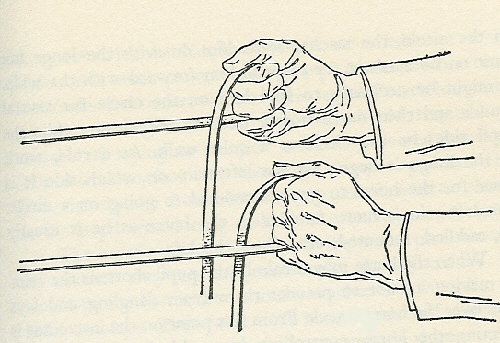IMEHA (International Model Equine Hobbyists Association) was an online photo showing site that existing until 2018. Included on the site were these guidebooks for judging and showing model horses in Performance classes. MEPSA has obtained permission to share the info contained in the guides.
Scoring :: Point Deducts :: Tack :: Set-Up Options :: Photo Examples
No doll rider is allowed in this class. Horses are judged on their abilities to be a pleasure style mount. Horses are asked to walk, trot, canter and sometimes hand gallop both directions of the arena, to stand in a line-up, rein-back. There are no additional patterns required for this class. Entries should work with a smooth regular gait, a natural willing and responsive headset; not necessarily fully flexed at the poll depending upon breed, conformation and style. They should show a forward – going way of impulsion and conformation consistent with a smooth and sustainable ride such a s a well-sloped shoulder, good pasterns, and a supple back with well-developed hind quarters. The demeanor of the horse (model) should be of happy and obedient participation in the class.
Some breeds have a distinct way of going that represent the huntseat standard for their breed. An example is the BHR Hunter, which is moving in a way that typifies the stock-type hunter but is not indictive of the movement of a sport-type huntseat pleasure mount. Huntseat Arabians tend to have slightly more action, although excessive action should be penalized. Entries that make reference to a breed association or particular national standard (AQHA, USFE, etc.) on the comment line saying that should get extra credit if the model is clearly performing to the standard.
(a) Hunters under saddle should be suitable to purpose. Hunters should move with long, low strides reaching forward with ease and smoothness, be able to lengthen stride and cover ground with relaxed, free-flowing movement, while exhibiting correct gaits that are of the proper cadence. The quality of the movement and the consistency of the gaits is a major consideration. Horses should be obedient, have a bright expression with alert ears, and should respond willingly to the rider with light leg and hand contact. Horses should be responsive and smooth in transition. When asked to extend the trot or hand gallop, they should move out with the same flowing motion. The poll should be level with, or slightly above, the withers to allow proper impulsion behind. The head position should be slightly in front of, or on, the vertical.
(b) This class will be judged on performance, condition and conformation. Maximum credit shall be given to the flowing, balanced, willing horse.
(c) Horses to be:
Shown at a walk, trot and canter both ways of the ring. Horses should back easily and stand quietly.
Reversed to the inside away from the rail.
(d) Horses may be asked to change to canter from the flatfooted walk or trot, at the judges discretion.
You Score Hunter Under Saddle Gaits on the following basis:
Faults to be scored according to severity:
(1) Quick, short or vertical strides
(2) Being on the wrong lead
(3) Breaking gait
(4) Excessive speed at any gait
(5) Excessive slowness in any gait, loss of forward momentum
(6) Failure to take the appropriate gait when called for
(7) Head carried too high
(8) Head carried too low (such that poll is below the withers)
(9) Overflexing or straining neck in head carriage so the nose is carried behind the vertical
(10) Excessive nosing out
(11) Failure to maintain light contact with horse’s mouth
(12) Stumbling
(13) If a horse appears sullen, dull, lethargic, emaciated, drawn or overly tired
(14) Consistently showing too far off the rail
Faults which will be cause for disqualification, except in novice amateur or novice youth, which shall be faults scored according to severity:
(1) Head carried too low (such that poll is below the withers consistently)
(2) Overflexing or straining neck in head carriage so the nose is carried behind the vertical consistently
Extra Credit Should Be Given If:
(1) Rein contact is steady but gentle at all times. It is referred to as ‘direct contact’ On a model entry this can be achieved by using sticky wax and makes the rein go in a direct straight line from the bit to the rider’s hand with no slack in the rein.
(2) Bight (Excess rein) of rein is draped on the right.
(3) Mane and tail braided with complementary color also should receive extra credit.
(4) an Entry Number is shown on saddle blanket or on rider’s back.
Points Should Be Deducted If:
(1) Model exhibits excessive speed for gait assigned.
(2) Model is on the wrong lead.
(3) Model appears to display a slowness in any gait or loss of forward momentum resulting in an animated and/or artificial gait at the lope.
(4) Model’s head is carried too high.
(5) Model’s head carried too low; tip of ear below the withers.
(6) Model is over flexed or has a strained neck in head carriage, so the nose is carried behind the vertical.
(7) Model displays excessive nosing out.
(8) Model displays an open mouth excessively.
(9) Rider uses spurs forward of the heart girth.
(10) Model appears sullen, dull, lethargic, emaciated, drawn or overly tired.
(11) Model appears agitated; has ears back, tail twirled, etc.
(12) Model displays quick, choppy or pony strides.
(13) Reins are draped and not a direct contact.
Required Tack:
Hunt seat bridles of matching leather with a cavesson noseband and bit, usually a snaffle bit. Most bits are legal however (snaffles of all types, pelhams and double bridles), it is assumed however that the rider is not relying upon a strong bit to control the horse, therefore a snaffle is recommended for this class. Stock Hunt Bridles generally have a white lining under the browband and noseband under the leather on the bridle. Bridles may be laced, braided or plain. Entries are often braided (usually on the right side of neck).
Prohibited Tack:
Boots, Martingales, Side Reins, Rein Stoppers, Figure-8, Flash and Drop Nosebands or other devices for controlling the headset are forbidden.
Set-Up Options:
Arena Fencing Required (Indoor or Outdoor Arena)
Types of Fencing Allowed:
- Painted or Natural
- Post and Rail
- Post and Plank
- Chain Link
- Solid Plyboard
- Plyboard with Top Rail
- Post with Drape Rope
- Stock Tube Pipe Rail
- Interior Arena Wall
Footing Required:
- Dirt
- Sand
- No rock base
Backboard or Natural Setting (Indoor or Outdoor)
Examples of the Four Breed Divisions:

Hunter Under Bareback
Stock Breed Entry
KR Hickory Lark shown as a Bay Tobiano Paint Gelding and mold is a CM Breyer Zippo. Shown by Veronica Geddie with the comment: Hickory walks on the rail in a youth amateur bareback class.

Hunter Under Bareback
Arabian Breed Entry
DA SIDI BISHIIR Arabian stallion wearing full double bridle by Corinne Ensorr. Horse and doll by Karon Grieve and shown by Karon Grieve..

Hunter Under Bareback
TB/WB or Sporthorse Breed Entry
FS Time Lord shown as a palomino TB stallion and mold is a AR Deputed Duke, sculpted and painted by Morgen Kilbourn. Shown in a full bridle by Jane Ashhurst.
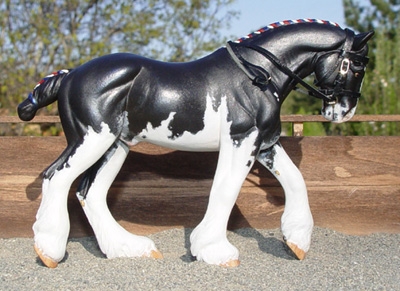
Hunter Under Bareback
Other Breed Entry
Wychwood Stout shown as a Black Sabino Shire Gelding. Mold is a CM Wild Safari Clydesdale by Janice Williford. Shown by Janice Williford.
Doll Rider Correct Seat and Hold the Reins Correctly:
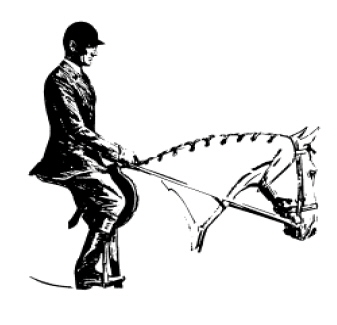
Correct Hunter Under Saddle Hunt Seat.
The reins are held between the ring fingers and pinkies with the thumbs solidly on top as they exit the hands. The grip is firm. Close the fingers for optimum communication and safety. Hold the hands just above the horse’s withers, in front of the saddle. Tip the thumbs toward each other at a 45-degree angle. Bend the elbows just enough to create a straight line through the forearms, hands, and reins to the horse’s mouth.
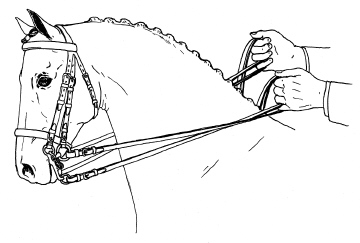
Double Bridle Reins – 2 and 2 Method. Most common handle hold in model horse hobby. It is advised that you put in your comment line what hold your set up is so that judge’s know you understand the three styles on holding the reins.

Double Bridle Reins – 3 in 1 Method. A true challenge for model horse hobbyists and doll rider’s with razor cut slips in the fingers of the hands. Left side curb goes directly back to hand and enters under ring finger with the left snaffle rein coming directly back and entering under the pinky finger with rein crossing over the curb rein. Right side curb rein goes directly back and enters under the middle finger of the left hand with all three reins coming up thru hand and out over the of the index finger with bight cascading down the right side. The right side snaffle goes directly and enters the hand under the ring finger, up into the hand and out over the top of the index finger with the bight draping down the right side. The look gives an ‘X’ to reins the left side of horse’s neck but a two independent rein look to the right side but only one rein going into the right hand. Very tricky set up.
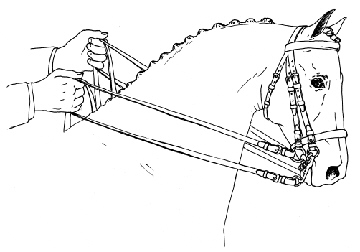
Double Bridle Reins – Fillis Method. The Fillis method of holding the reins is when the curb reins enter the rider’s hand from the bottom, around the little fingers and up to the second joint of the index fingers while the snaffle enters the fist from above over the index fingers. Each hand holds two reins.

